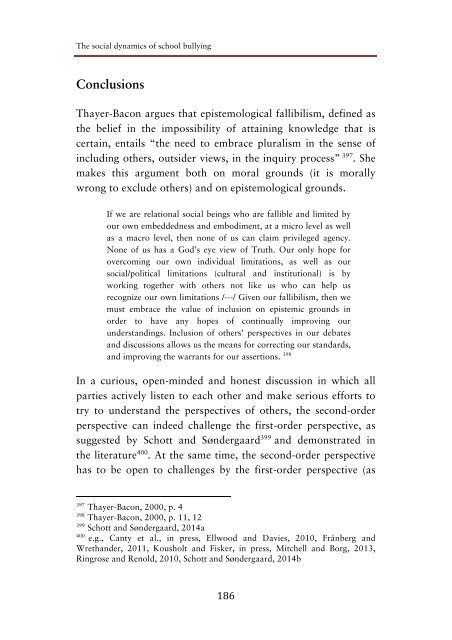Create successful ePaper yourself
Turn your PDF publications into a flip-book with our unique Google optimized e-Paper software.
The social dynamics of school bullying<br />
Conclusions<br />
Thayer-Bacon argues that epistemological fallibilism, defined as<br />
the belief in the impossibility of attaining knowledge that is<br />
certain, entails “the need to embrace pluralism in the sense of<br />
including others, outsider views, in the inquiry process” 397 . She<br />
makes this argument both on moral grounds (it is morally<br />
wrong to exclude others) and on epistemological grounds.<br />
If we are relational social beings who are fallible and limited by<br />
our own embeddedness and embodiment, at a micro level as well<br />
as a macro level, then none of us can claim privileged agency.<br />
None of us has a God’s eye view of Truth. Our only hope for<br />
overcoming our own individual limitations, as well as our<br />
social/political limitations (cultural and institutional) is by<br />
working together with others not like us who can help us<br />
recognize our own limitations /---/ Given our fallibilism, then we<br />
must embrace the value of inclusion on epistemic grounds in<br />
order to have any hopes of continually improving our<br />
understandings. Inclusion of others’ perspectives in our debates<br />
and discussions allows us the means for correcting our standards,<br />
and improving the warrants for our assertions. 398<br />
In a curious, open-minded and honest discussion in which all<br />
parties actively listen to each other and make serious efforts to<br />
try to understand the perspectives of others, the second-order<br />
perspective can indeed challenge the first-order perspective, as<br />
suggested by Schott and Søndergaard 399 and demonstrated in<br />
the literature 400 . At the same time, the second-order perspective<br />
has to be open to challenges by the first-order perspective (as<br />
397<br />
Thayer-Bacon, 2000, p. 4<br />
398<br />
Thayer-Bacon, 2000, p. 11, 12<br />
399<br />
Schott and Søndergaard, 2014a <br />
400<br />
e.g., Canty et al., in press, Ellwood and Davies, 2010, Frånberg and<br />
Wrethander, 2011, Kousholt and Fisker, in press, Mitchell and Borg, 2013,<br />
Ringrose and Renold, 2010, Schott and Søndergaard, 2014b<br />
186


